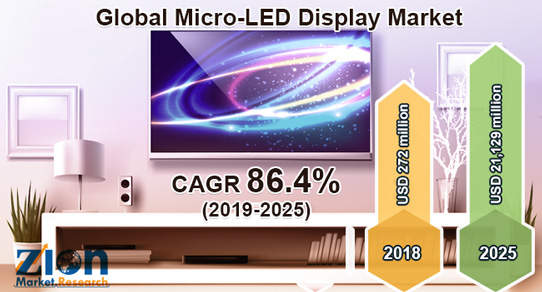- News
1 April 2019
Micro-LED display market growing at 86.4% CAGR from $272m in 2018 to $21,129m in 2025
The micro-LED display market was about $272m in 2018 and will rise at a compound annual growth rate (CAGR) of 86.4% from 2019 to $21,129m in 2025, forecasts Zion Market Research in its report ‘Micro-LED Display Market, 2018–2025’.

As an emerging flat-panel display technology that provides what is reckoned to be unbeatable contrast and energy efficiency through microscopic LED arrays, micro-LED displays are based on gallium nitride (GaN) technology, providing 30 times more brightness as well as better efficiency than conventional organic light-emitting diode (OLED) displays, it is claimed. Other benefits include better contrast, compact display size, and a faster response time.
Global commercialization of micro-LED displays is still in the emerging phase, but growing demand for brighter and more energy-efficient displays is expected to drive the market over the forecast timeframe, notes the report. Demand for micro-LED displays that are compact in size with an excellent viewing angle is flourishing worldwide, it adds. The implementation of micro-LED displays is currently at its peak, as it provides a brighter picture with high pixel resolution and what is reckoned to be unbeatable energy efficiency. Display manufacturers are seen to be opting for micro-LED solutions to improve the overall consumer experience. Additionally, the high penetration rate of micro-LED displays is also due to their high pixel resolution and image quality. Furthermore, the continuous demand for reduction in display size will contribute notably to driving the micro-LED display market, the report adds. However, escalating demand for flexible and foldable display technology may constrain the micro-LED display market to some extent.
The micro-LED display market is segmented on the basis of panel size, application and vertical. Based on panel size, the micro-LED display market is segmented into small [<10.5”], medium [10.5”–65”] and large [>65]. By application, it is segmented into virtual reality (VR) headsets, augmented reality (AR) headsets, smartphones, smartwatches, tablets, TVs, laptops, head-up displays (HUDs) and digital signage. The micro-LED smartwatch segment is expected to see rapid market growth in the future, due to its growing commercialization. By vertical, the market includes automotive, consumer electronics, aerospace & defense, and advertising. The consumer electronics segment is projected to hold a prominent market share in the years ahead, due to the flourishing demand for micro-LED display in smartwatches, smartphones, and tablets.
By region, North America held a prominent share of the micro-LED display market in 2018, due to the presence of leading micro-LED display manufacturers. The USA is projected to dominate this regional market as it is the corporate headquarter of numerous renowned market players such as Apple, Oculus VR, VerLASE Technologies, Lumiode, Uniqarta, etc, notes the report. Furthermore, the region is seeing many market-relevant business activities that are contributing significantly to overall market demand.
The rising automotive application of micro-LED displays is driving the market in European countries. Demand for micro-LEDs is trending in the automotive industry for various applications, such as rearview windows, in-car entertainment systems, dashboards and HUDs. Furthermore, the automotive sector plays a vital role in Europe’s growth in gross domestic product (GDP), comprising nearly 4% of overall GDP in 2018. Many auto makers are involved in R&D activities to strengthen their overall competitiveness.
The Asia Pacific region is likely to see rapid market growth in the coming years due to the flourishing consumer electronics industry. In emerging economies such as India and China, conventional lighting is being replaced by LED lighting, which is contributing significantly toward the regional market. Moreover, awareness about the benefits offered by micro-LED displays has attracted many lighting manufacturers. Rising investment by LED lighting manufacturers for the technological enhancement of LED displays is expected to drive significant growth in the micro-LED display market in the future.
In Latin America, the rising number of technically advanced smartphones is playing a vital role in driving the micro-LED display market. This regional growth can be attributed to the compact size and high resolutions of micro-LED displays and the huge investments made by numerous smartphone makers into integrating micro-LED displays. Also driving this regional market is growth in the total number of smartphone users in Latin America from 155.9 million in 2015 to an expected 245.6 million by 2019.
In the Middle East and Africa, the market demand for micro-LED displays is trending due to the growing use of smart wearable devices such as smartwatches. Nowadays, smartwatches are used for various purposes (i.e. from calling to GPS tracking). In 2018, the sales of smartwatches in the Middle East and Africa accounted for over 1.1 million.
The report cites key players in the micro-LED display market as Samsung Electronics, Sharp Electronics, LG Display, Sony, AU Optronics, VerLASE Technologies, Lumiode, Apple Inc, X-Celeprint, Rohinni, Oculus VR, Epistar, Lumens, Aledia, Cooledge Lighting, Nichia, JBD, Plessey Semiconductors, Ostendo Technologies, VueReal, ALLOS Semiconductors, Uniqarta, Mikro Mesa Technology, and PlayNitride.
www.zionmarketresearch.com/report/micro-led-display-market


